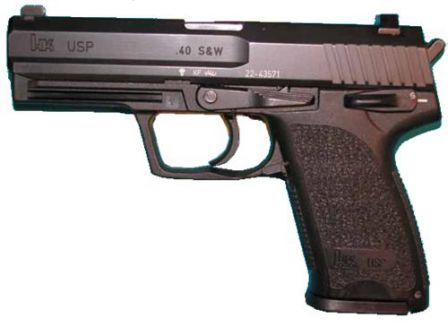HK USP in .40SW - basic version.
HK USP in .45ACP.
HK USP .45 Tactical with extended barrel, threaded for sound suppressor (threads are covered by protector).
HK USP Compact .45ACP.
USP - cutaway.
The family of the USP handguns.
Characteristics
Type: Double Action or Double Action Only
Calibers: 9x19mm Luger, .40 S&W, .45 Auto, .357SIG (USP Compact only)
Dimensions (9 x 19 version)
Length: 194 mm
Height: 136 mm
Width: 32 mm
Weight: 720 g
Capacity: USP, USP Match - 15 rds (9mm), 13 rds (.40), 12 rds (.45); USP Compact - 13 rds (9mm), 12 rds (.357 and .40), 8 rds (.45)
Heckler & Koch started the development of a new Universal Selbstlade Pistole (Universal Self-loading Pistol, or USP in short), in mid-1989. The concept of the new design was to provide a universal weapon for police and military forces, available in a variety of versions and sizes. The target market for this new weapon was apparently the USA, as the first version of the pistol, which appeared in 1993, was chambered for a new American cartridge, the .40 S&W. A 9mm version appeared a little later, and in 1995 the slightly modified 9mm USP pistol was adopted by the Bundeswehr (German army) as its new service pistol, under the designation P8. The same year the company also brought out another “America-special” version of the USP, this time in.45 ACP caliber. In 1996 the first of the Compact series of USP pistols entered production, and next year it was officially approved for German police use as the 9mm P10. Several versions of the USP were also made specifically for civilian markets, such as the USP Expert, USP Elite and USP Match. There are also several special-purpose versions of the USP. These include two original variations fitted with extended threaded barrels to be used with silencers, the .45 caliber USP Tactical and 9mm USP 9 SD, recently joined by the .45 caliber USP 45 Compact Tactical, sometimes preferred by the US Military users over the much bulkier and heavier Mark 23 Model 0 pistol of the same caliber.
USP pistols are short-recoil operated, locked-breech pistols with a polymer frame. The barrel is locked to the slide by a single lug, which engages the ejection port. Unlocking is controlled by a cam-shaped extension below the chamber, which interacts with a steel insert set into the frame. Barrels on all USP pistols have polygonal rifling, except the earliest production pistols made in 1993, and all German army P8’s. The captive recoil spring assembly includes an additional recoil spring buffer on full-size pistols and a polymer buffer on Compact pistols. The trigger is double-action, with an external hammer, an automatic firing pin safety and a frame-mounted lever, which may operate differently in different versions of the pistols, as described below. Each pistol can be easily adjusted by a gunsmith to any of the trigger mode configurations, with the replacement of a few parts that include a cam plate and a safety lever. The sights are dovetailed to the slide. Magazines on most USP pistols are of steel construction, but Bundeswehr-owned P8 pistols have semi-translucent polymer magazines. Magazine release levers are ambidextrous and located at the base of the trigger-guard.
There are nine basic variations of the USP trigger/safety arrangements, plus one specific to P8 pistols, as follows:
1. Double action trigger with manual safety on the left side. If lever is pressed below the “fire” position, it acts as a decocker, bringing the hammer down and then returning to the fire position
2. Same as No.1, but the safety lever on the right side
3. Double action trigger with decock-only lever on the left side
4. Same as No.3 but the lever on the right side
5. Double-action-only trigger with manual safety lever on the left side.
6. Same as No.5 but the lever on the right side
7. DAO trigger without any manual safety
8. P8 pistol, with “inverted” safety lever, that is, upper position of the lever is for fire and lower for safe. When the safety is applied, the hammer is decocked automatically
9. Double action trigger with manual safety on the left side. No safe decocking functionality is provided
10. Same as No.9 but the lever on the right side
2. Same as No.1, but the safety lever on the right side
3. Double action trigger with decock-only lever on the left side
4. Same as No.3 but the lever on the right side
5. Double-action-only trigger with manual safety lever on the left side.
6. Same as No.5 but the lever on the right side
7. DAO trigger without any manual safety
8. P8 pistol, with “inverted” safety lever, that is, upper position of the lever is for fire and lower for safe. When the safety is applied, the hammer is decocked automatically
9. Double action trigger with manual safety on the left side. No safe decocking functionality is provided
10. Same as No.9 but the lever on the right side
How to field-strip (disassemble) HK USP pistol: 1) remove the magazine by pressing the magazine release button; 2) check that the chamber is empty; 3) retract the slide partially, so the slide release lever axle is aligned with the disassembly notch on the slide; 4) press on the slide release axis pin from the right side of the frame, then pull the slide release lever completely from the left side; 5) carefully ease the slide forward, then pull it toward the front out of the frame; 6) remove the return spring assembly from below the barrel; 7) pull the barrel out of the slide.
Reassemble in reverse order.
Reassemble in reverse order.


 13.25
13.25
 Jack The Ripper
Jack The Ripper







 Posted in:
Posted in:
0 komentar:
Posting Komentar